Rowena Wiseman's Blog, page 2
November 30, 2021
Publishers accepting unsolicited manuscripts

These are the three best resources for finding a publisher. And it has taken me years to find them! Now, I'm going to share them with you!
After hard work and dedication (and endless hours of struggle), you have finally finished your manuscript! Or perhaps you aren’t quite done, but you are close enough that it is time to start thinking about the next step. No matter where you are in the writing a novel process, it will be useful to make a plan of action for your finished manuscript.
There are, in fact, some editors from traditional publishers looking for new authors. Some publishing houses even have open submissions.
Sure you can do a google search for:‘publishers accepting submissions’ ‘publishers accepting unsolicited manuscripts’
The Google search works well. That is how I started. I’ve sent off many manuscripts by finding publishers such as Penguin or HarperCollins who have open submission processes via Google.
However, after 15 years, I’ve finally discovered three excellent resources that I now use to find publishers who accept unsolicited manuscripts.
1. Duotrope Duotrope is an award-winning resource that has a great search tool for writers to find literary agents and publishers accepting unsolicited manuscripts. Writers can also track their submissions within the software.
From $7.50 a month you get access to an incredible search engine of literary agents and publishers accepting submissions.
For fiction writers, you type in the genre you have written, the style (eg literary, fantasy, mystery etc), the audience (young adult, commercial etc), the length (novel, novella, short story etc) and the number of words. You can also select publication medium (print or digital).
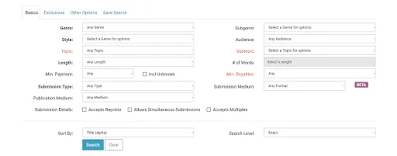
You can then sort the results by the response time of those literary agents or publishers or even by the acceptance percentage! You can also save your searches, to come back to later.
In the submissions tracker you can record who you sent a particular novel to and what date. You can then come back to this and note if the manuscript was acknowledged, accepted, or rejected, or never responded.
Check out Duotrope here.
2. Manuscript WishListManuscript WishList is a fabulous resource to find publishers and literary agents who are accepting manuscripts.
Go to the genre search https://www.manuscriptwishlist.com/find-agentseditors/search/.
Select either agent or editor and the genre (fiction and non fiction genres available).

The ManuscriptWishlist will then give you hundreds of agents or editors to search through. Click into each profile and read their bio, as well as a description about the type of manuscripts they are interested in. This information is invaluable. You can quickly tell whether they would be interested in the type of manuscript you have written.
There is also information about each literary agent or publishing editor's submission guidelines and links to their website or email for where you can find out more information about submitting your manuscript.
This has seriously been an absolute gem in finding literary agents and publishers to submit my manuscript to.
Check out Manuscript WishList here.
3. Writing Tips Oasis
I don’t know how they do it, but Writing Tips Oasis has some of the best lists of publishers accepting unsolicited manuscripts that I have come across.
They seem to be constantly updating their lists and also have really niche lists such as:
21 Australian publishers accepting unsolicited manuscripts19 Top Publishers for First Time Authors
I love how they really narrow down their lists of publishers open for submissions for authors.
Find the search bar and type in your book’s genre and see which lists Writing Tips Oasis comes up with. They may even have lists of publishers to find in your country.
Check out Writing Tips Oasis here.
So, along with Google these are my top 3 resources for authors looking to submit their manuscripts. These are great resources for finding the right publishers. And remember, to keep track of your submissions. Use Duotrope, or a basic spreadsheet. Track the name of the publisher, the date and the response. Even if you get a lukewarm response, track it. You can send a new manuscript to that editor and say ‘remember me’.
If you’re a serious writer, you’ll have years of submitting ahead of you. So get a system in place. Learn about how to construct the best type of query letter. Listen to the Manuscript Academy podcast. They have agents reading out query letters and responding to them in real time. The Manuscript Academy is by the same people as the Manuscript WishList – and their podcast is brilliant at teaching writers how to write the best query letter possible. Sure, you’ve written a book, but the query letter is even more important! So you need to get it right.
I hope you now have a few resources under your belt to start submitting your manuscript.
Good luck with it!
_________________________________________
Sign up to receive a free 7-step action plan to become a published author!
-improve focus and productivity
-must-have writing software
-agents and publishers seeking manuscripts
Which publishers accept unsolicited manuscripts

These are the three best resources for finding a publisher. And it has taken me years to find them! Now, I'm going to share them with you!
After hard work and dedication (and endless hours of struggle), you have finally finished your manuscript! Or perhaps you aren’t quite done, but you are close enough that it is time to start thinking about the next step. No matter where you are in the writing a novel process, it will be useful to make a plan of action for your finished manuscript.
There are, in fact, some editors from traditional publishers looking for new authors. Some publishing houses even have open submissions.
Sure you can do a google search for:‘publishers accepting submissions’ ‘publishers accepting unsolicited manuscripts’
The Google search works well. That is how I started. I’ve sent off many manuscripts by finding publishers such as Penguin or HarperCollins who have open submission processes via Google.
However, after 15 years, I’ve finally discovered three excellent resources that I now use to find publishers who accept unsolicited manuscripts.
1. Duotrope Duotrope is an award-winning resource that has a great search tool for writers to find literary agents and publishers accepting unsolicited manuscripts. Writers can also track their submissions within the software.
From $7.50 a month you get access to an incredible search engine of literary agents and publishers accepting submissions.
For fiction writers, you type in the genre you have written, the style (eg literary, fantasy, mystery etc), the audience (young adult, commercial etc), the length (novel, novella, short story etc) and the number of words. You can also select publication medium (print or digital).

You can then sort the results by the response time of those literary agents or publishers or even by the acceptance percentage! You can also save your searches, to come back to later.
In the submissions tracker you can record who you sent a particular novel to and what date. You can then come back to this and note if the manuscript was acknowledged, accepted, or rejected, or never responded.
Check out Duotrope here.
2. Manuscript WishListManuscript WishList is a fabulous resource to find publishers and literary agents who are accepting manuscripts.
Go to the genre search https://www.manuscriptwishlist.com/find-agentseditors/search/.
Select either agent or editor and the genre (fiction and non fiction genres available).

The ManuscriptWishlist will then give you hundreds of agents or editors to search through. Click into each profile and read their bio, as well as a description about the type of manuscripts they are interested in. This information is invaluable. You can quickly tell whether they would be interested in the type of manuscript you have written.
There is also information about each literary agent or publishing editor's submission guidelines and links to their website or email for where you can find out more information about submitting your manuscript.
This has seriously been an absolute gem in finding literary agents and publishers to submit my manuscript to.
Check out Manuscript WishList here.
3. Writing Tips Oasis
I don’t know how they do it, but Writing Tips Oasis has some of the best lists of publishers accepting unsolicited manuscripts that I have come across.
They seem to be constantly updating their lists and also have really niche lists such as:
21 Australian publishers accepting unsolicited manuscripts19 Top Publishers for First Time Authors
I love how they really narrow down their lists of publishers open for submissions for authors.
Find the search bar and type in your book’s genre and see which lists Writing Tips Oasis comes up with. They may even have lists of publishers to find in your country.
Check out Writing Tips Oasis here.
So, along with Google these are my top 3 resources for authors looking to submit their manuscripts. These are great resources for finding the right publishers. And remember, to keep track of your submissions. Use Duotrope, or a basic spreadsheet. Track the name of the publisher, the date and the response. Even if you get a lukewarm response, track it. You can send a new manuscript to that editor and say ‘remember me’.
If you’re a serious writer, you’ll have years of submitting ahead of you. So get a system in place. Learn about how to construct the best type of query letter. Listen to the Manuscript Academy podcast. They have agents reading out query letters and responding to them in real time. The Manuscript Academy is by the same people as the Manuscript WishList – and their podcast is brilliant at teaching writers how to write the best query letter possible. Sure, you’ve written a book, but the query letter is even more important! So you need to get it right.
I hope you now have a few resources under your belt to start submitting your manuscript.
Good luck with it!
_________________________________________
Sign up to receive a free 7-step action plan to become a published author!
-improve focus and productivity
-must-have writing software
-agents and publishers seeking manuscripts
November 21, 2021
Bookbolt: Create A Low Content Book In Minutes

What is a low content book?
It’s easy to generate passive income by publishing a low content book.
As the name indicates, a book that has little to no text is called a low content book. Some examples of low content books are notebooks, sketchbooks, planners, recipe books and journals.
The best thing about low content books is you can create them in just a few hours, but they can help you make a small amount of passive income per month. Some of the benefits of low content books:
• You can create them quickly
• There is no need to have a website or email list
• You don’t need to hire writers or write it yourself
• No upfront investment of money
• No need to keep inventory because everything will be managed on Amazon KDP.
How do you create low content books on BookBolt?The good news is you can create a low content book on BookBolt in less than an hour.
You need to design the book cover and inner pages. You can do this on BookBolt, or you can hire a graphic designer for this task.
You need two files (one pdf for the cover and one pdf for the interior). In the BookBolt Designer feature you can create both the cover and the interior.
For the cover, import images with the drag and drop option. Or you can design the low content book cover in Canva easily, just choose one of their book cover templates.
For the interior of the book, you can use The BookBolt Designer. They have many templates you can choose from for the interior pages of recipe books, journals, weekly planners etc.
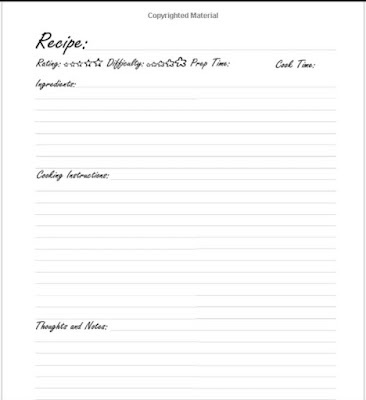
Another cool feature to create books with BookBolt is the https://designer.bookbolt.io/interior... which allows you to combine different ready to use interiors and make the book unique.
Come up with a unique idea for low content booksThere are many low content books on Amazon, so try and think of something unique.
I've created 4 low content books using the BookBolt templates.
One that I'm particularly fond of is my Moving out of home: Feel good recipes from home recipe book.
When I created this book, my idea was that parents could handwrite recipes in this book for when their child is moving out of home with recipes they enjoyed from home. It's a cute little gift to help their child start cooking and to feel comforted by recipes from their childhood.

I asked Iara Rudy, Head Of Business Development at BookBolt her best tips for listing low content books on Amazon. She said:
'RESEARCH, RESEARCH and more RESEARCH. Before I start designing a low content book to put up for sale on Amazon I need to ensure there is a demand and low competition. This is why I think BookBolt is very valuable: I can get information that I would not be able to obtain without it. I know which are the best sellers in every book category, I know the best sellers pricing strategy and how do they look like.
Furthermore, spending a good time finding the right keywords with BookBolt will determine sales. We need to list the low content books with the keywords our audience is using when searching on Amazon.'
You will need to create an Amazon KDP Account - carefully fill in your tax information and also read the terms and conditions.
After creating your Amazon KDP account, the next step is to sign in and provide Paperback details in the Bookshelf section. For example, you need to provide the Book title, Author name, Short Description of your book, and sales price. Again, look at other examples of low content books, so that your book is competitive in sales price. BookBolt also has videos with tips for finding suitable categories on Amazon.
Best practice for marketing low content books and driving salesBookBolt has a number of posts on their website for building a brand and getting reviews and creating Amazon ads to promote low content books. This is going to be the hard part, but the most crucial part in driving attention to your book. Stick with it. Create a business plan. Decide how much you want to invest in advertising and what your returns will be. If you have a social media platform - spread the word through these!
Click here to find out more about BookBolt and how you can create your own low content book.
Enter the following Coupon Code to get 20% off BookBolt: outofprint
_________________________________________
Sign up to receive a free 7-step action plan to become a published author!
-improve focus and productivity
-must-have writing software
-agents and publishers seeking manuscripts
Bookbolt: The Ultimate Guide To Creating A Low Content Book In Minutes

What is a low content book?
It’s easy to generate passive income by publishing a low content book.
As the name indicates, a book that has little to no text is called a low content book. Some examples of low content books are notebooks, sketchbooks, planners, recipe books and journals.
The best thing about low content books is you can create them in just a few hours, but they can help you make a small amount of passive income per month. Some of the benefits of low content books:
• You can create them quickly
• There is no need to have a website or email list
• You don’t need to hire writers or write it yourself
• No upfront investment of money
• No need to keep inventory because everything will be managed on Amazon KDP.
How do you create low content books on BookBolt?The good news is you can create a low content book on BookBolt in less than an hour.
You need to design the book cover and inner pages. You can do this on BookBolt, or you can hire a graphic designer for this task.
You need two files (one pdf for the cover and one pdf for the interior). In the BookBolt Designer feature you can create both the cover and the interior.
For the cover, import images with the drag and drop option. Or you can design the low content book cover in Canva easily, just choose one of their book cover templates.
For the interior of the book, you can use The BookBolt Designer. They have many templates you can choose from for the interior pages of recipe books, journals, weekly planners etc.

Another cool feature to create books with BookBolt is the https://designer.bookbolt.io/interior... which allows you to combine different ready to use interiors and make the book unique.
Come up with a unique idea for low content booksThere are many low content books on Amazon, so try and think of something unique.
I've created 4 low content books using the BookBolt templates.
One that I'm particularly fond of is my Moving out of home: Feel good recipes from home recipe book.
When I created this book, my idea was that parents could handwrite recipes in this book for when their child is moving out of home with recipes they enjoyed from home. It's a cute little gift to help their child start cooking and to feel comforted by recipes from their childhood.

I asked Iara Rudy, Head Of Business Development at BookBolt her best tips for listing low content books on Amazon. She said:
'RESEARCH, RESEARCH and more RESEARCH. Before I start designing a low content book to put up for sale on Amazon I need to ensure there is a demand and low competition. This is why I think BookBolt is very valuable: I can get information that I would not be able to obtain without it. I know which are the best sellers in every book category, I know the best sellers pricing strategy and how do they look like.
Furthermore, spending a good time finding the right keywords with BookBolt will determine sales. We need to list the low content books with the keywords our audience is using when searching on Amazon.'
You will need to create an Amazon KDP Account - carefully fill in your tax information and also read the terms and conditions.
After creating your Amazon KDP account, the next step is to sign in and provide Paperback details in the Bookshelf section. For example, you need to provide the Book title, Author name, Short Description of your book, and sales price. Again, look at other examples of low content books, so that your book is competitive in sales price. BookBolt also has videos with tips for finding suitable categories on Amazon.
Best practice for marketing low content books and driving salesBookBolt has a number of posts on their website for building a brand and getting reviews and creating Amazon ads to promote low content books. This is going to be the hard part, but the most crucial part in driving attention to your book. Stick with it. Create a business plan. Decide how much you want to invest in advertising and what your returns will be. If you have a social media platform - spread the word through these!
Click here to find out more about BookBolt and how you can create your own low content book.
Enter the following Coupon Code to get 20% off BookBolt: outofprint
_________________________________________
Sign up to a free 7-step author journey program!
Everything you need to know about writing and publishing in the digital revolution!
October 24, 2021
Tips on how to write a novel - The Novel Factory

Are you just starting out on writing a novel and need some tips to help you along? Do you need help developing your characters and creating a strong plot to keep your readers turning the page?
Or are you an experienced writer but you're a pantser (like me) and would like to learn how to plan your novel better?
Let me introduce The Novel Factory!
The Novel Factory has researched all the necessary elements of a great novel and developed inexpensive software that gives writers a clear roadmap to help them write their novel.
The Novel Factory encourages writers to start with a clear plan, to develop characters and settings, goals and subplots.
The short videos and step-by-step guides are like a professional writing course on steroids. They've narrowed down the most important tips on how to write a novel and have created worksheets that writers can fill out to track their characters, settings and world-building.
How The Novel Factory gives you tips on how to write a novelYou can sign up with a free 30-day trial (from $7.50 a month thereafter). The Novel Factory gives you a clear roadmap to start and complete your novel in 15 steps. From the initial idea (the premise), through to outlining the plot, character development, scene blocking, first draft, locations, subplots, through to the final draft.

Watch the introduction video on how the roadmap works. You can also read about practical tips on writing, such as creating a daily habit and finding a safe space to write.
Go through and read the tips and watch the videos in each of the 15 steps in the roadmap to understand how The Novel Factory software works and the kind of ideas you will need to outline your novel.
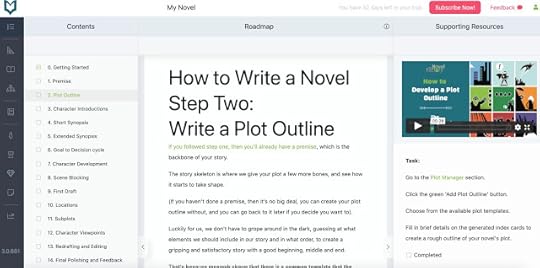
Once you understand the 15 steps in the roadmap, it is time to get started. Click on the left hand bar to work through each step. Fill out your premise and the short and long synopsis. The Novel Factory will give you prompts for each step.

The Plot Manager is one of the best features in The Novel Factory. The Plot Manager actually gives you plot templates to work with! This is genius - as it guides you through the most important elements needed in classic types of stories such as the Hero's Journey, Romance, Mystery or Detective.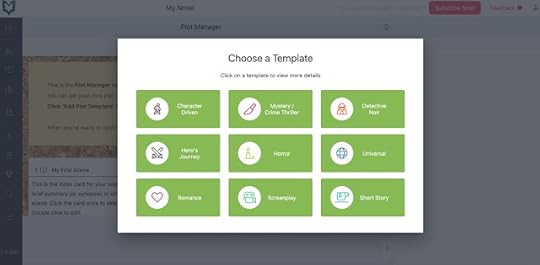

The software then pre-fills those scenes into index cards - to further give you tips on how to write the novel for that genre. Here is an example of the index cards for the Hero's Journey:

Once you have filled in the index cards, you will be able to see an overview of all the main scenes in your novel and how you are going to get from A-Z.
Click on manuscript in the left toolbar and all the index card information that you have filled in will populate on the right hand side, and now you can start writing the manuscript with the clear guide you have already set up!
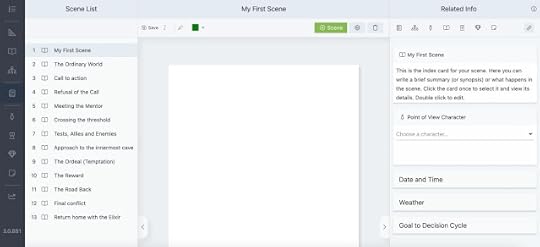
You can develop your characters in the character tab:

Fill out as many questions as you can to get a really clear idea about your characters - their childhood, their flaws, their wishes, their quirks and mannerisms. Get to know your characters inside out! How do they talk? What do they look like? Go into as much detail as possible here.
If you are writing a novel with world-building the Locations and Items tabs will help you visualise and keep track of the unique world you are creating.
Finally, you can use the Notes tab to keep track of research material, links, images and even create your own checklist.
The Novel Factory is sophisticated software to help you write your novel. The built-in tips guide you as you go along. Take your time and read the tips, watch the videos and fill out the question prompts as much as possible. This will give you a clear idea of where you are heading with your novel and a deeper understanding of your characters and the world you are building.
The Novel Factory really is a writer's best friend. It will give you all the tips you need to write a novel. Try The Novel Factory free 30-day trial here.
After the free trial, the software costs from $7.50 a month thereafter, or you can sign up for an annual plan. You will be able to use any upgrades and new features.
Subscribe to my newsletter to receive my subscriber-only cheatsheet top 8 tools and resources for writers.
You'll receive occasional emails with further tips for writing and publishing in the digital revolution!
#mc_embed_signup{background:#fff; clear:left; font:14px Helvetica,Arial,sans-serif; } /* Add your own Mailchimp form style overrides in your site stylesheet or in this style block. We recommend moving this block and the preceding CSS link to the HEAD of your HTML file. */ SubscribeOctober 11, 2021
Best tips from book blurb writers on how to write a book blurb

After the front cover design, back cover blurbs are the second most important sales tool for a book - so it's important to get it right. Personally, I prefer writing a 60,000 word novel than a 200 word blurb! It is so hard to condense your novel succinctly, while making it enticing for a potential reader, agent or publisher.
I asked three professional book blurb writers from Fiverr their best tips on writing a back cover blurb.
I also wanted to find out how they work with authors to write a book blurb for them. (Because sometimes getting someone else to write a book blurb is better than writing it yourself!)
Personally, I've written a blurb for a novel and then sent it to a friend who is an editor to rework. By getting two eyes on it and two different impressions I was able to riff off her ideas and even improve it further.
Read through to the end, where I give examples of two book blurbs that I think are absolutely excellent!
Best tips for how to write a book blurbellswrites:Spread the paragraphs apart. Some people are put off with massive chunks of text, so once it’s spread out it’s easier to read.
Make sure that your writing fits the genre of the book.
Try to hint at plot points in the book but not give spoilers away. If you want to subtly mention a spoiler, try putting it in question form instead.
Ensure that the word count isn’t too long. 100-200 words are usually the best unless specified otherwise. If you give away too much on the back cover it could discourage readers.
Have a look at other examples.
Make sure the first and last line make the reader want to find out more. Sometimes I use a question or quote from the author depending on the requirements.
Try writing it in first person if third isn’t working out. Sometimes if you delve into the character of the book it creates a more emotive blurb. But always check with the author first.
Visit ellswrites' profile on Fiverr
paigedown:The most important part of the back cover is the hook and how you present that hook. The first part deals with how the hook is written. It should give readers a taste of what the book will be about, without giving away the best pieces. Authors should avoid cliches and plot spilling! Sometimes including a sentence or two from their book will give readers a window into the plot and characters of the book to build the suspense.
My second tip is to format the hook differently. With the rise in e-books and self-publishing, it is important to format the blurb with bold and italics creates a visual effect that draws the reader in. Most importantly emphasizing the hook! Many authors rely on online sales and by changing the format it can create even more intrigue.
A book blurb should be between 100-200 words! Too long and readers will know all about your book with no reason to buy it. Too short and readers won’t know what the book is about and move on to the next one.
Writing an enticing blurb is a balancing act of concise word choice and captivating your audience.
Visit paigedown's profile on Fiverr
lwagensveld85:When I write a blurb I read through the information I have on the story and pick out the most intriguing bits, then I try to elude to them without giving too much away. You want enough info to grab people's attention, without revealing too many secrets. The other thing I try to do is always end the blurb with an enticing question. That way the person looking at that book will have to read it to get answers!Visit lwagensveld85's profile on Fiverr

How book blurb writers work with authorsEllswrites:
Usually authors message me before placing an order to discuss what they would like and any extra requirements they are interested in. This can be from multiple books or possible proofreading so I can create a custom offer specifically for that.
But with the actual blurb process, I tend to request a rough outline of the book so I can get an idea of the story. There’s a slight difference between the fiction and non fiction blurbs too. With fiction the author usually provides a synopsis and with non fiction they sometimes provide chapter titles, reviews or direct quotes.
After I receive the information, I produce a first draft of the blurb for them to look over and see if there’s anything they would like me to add or change.
Once they’re completely happy with the blurb I can deliver the order.
Get help writing your book blurb from ellswrites on Fiverr
Paigedown:When I am starting a book blurb, I like to get as much information as possible from the author. I don’t want to read the entire novel, but if I can understand the characters, plot and the world that the author is creating, I become invested in their book and can write about it. There is no such thing as too much details. With full details it allows me to pair down the summary and really find what makes their book special and what will hook the reader.
Get help writing your book blurb from paigedown on Fiverr
lwagensveld85:When I do a blurb I ask the buyer to send me an outline, or a synopsis if it is longer. The best thing I've found though is a well written outline. This is an outline in the sense of what you'd send to a publisher, or use to plan the book. It should have the characters, plot points, the acts, etc. That way I have a clear idea what I'm writing about. I also like to read an introduction, or a first chapter to get a sense of the writer's style and voice. What isn't ideal, is a paragraph or two scribbled last minute that vaguely explains the book.
Get help writing your book blurb from lwagensveld85 on Fiverr
Examples of excellent book blurbsToni Jordan's Addition (Text Publishing)Grace Lisa Vandenburg counts. The letters in her name (19). The steps she takes every morning to the local café (920); the number of poppy seeds on her slice of orange cake, which dictates the number of bites she’ll take to finish it. Grace counts everything, because numbers hold the world together. And she needs to keep an eye on how they’re doing.
Seamus Joseph O'Reilly (also a 19, with the sexiest hands Grace has ever seen) thinks she might be better off without the counting. If she could hold down a job, say. Or open her kitchen cupboards without conductng an inventory, or make a sandwich containing an unknown number of sprouts. Grace’s problem is that Seamus doesn’t count. Her other problem is…he does.
Kristen Krauth's just_a_girl (UWA Publishing)Layla is only 14. She cruises online. She catches trains to meet strangers. Her mother, Margot, never suspects. Even when Layla brings a man into their home. Margot’s caught in her own web: an evangelical church and a charismatic pastor. Meanwhile, downtown, a man opens a suitcase and tenderly places his young lover inside.
just_a_girl tears into the fabric of contemporary culture. A Puberty Blues for the digital age, a Lolita with a webcam, it’s what happens when young girls are forced to grow up too fast. Or never get the chance to grow up at all.
_________________________________________
Sign up to receive a free 7-step action plan to become a published author!
-improve focus and productivity
-must-have writing software
-agents and publishers seeking manuscripts
How to write a book blurb

After the front cover design, back cover blurbs are the second most important sales tool for a book - so it's important to get it right. Personally, I prefer writing a 60,000 word novel than a 200 word blurb! It is so hard to condense your novel succinctly, while making it enticing for a potential reader, agent or publisher.
I asked three professional book blurb writers from Fiverr their best tips on writing a back cover blurb.
I also wanted to find out how they work with authors to write a book blurb for them. (Because sometimes getting someone else to write a book blurb is better than writing it yourself!)
Personally, I've written a blurb for a novel and then sent it to a friend who is an editor to rework. By getting two eyes on it and two different impressions I was able to riff off her ideas and even improve it further.
Read through to the end, where I give examples of two book blurbs that I think are absolutely excellent!
Best tips for how to write a book blurbellswrites:Spread the paragraphs apart. Some people are put off with massive chunks of text, so once it’s spread out it’s easier to read.
Make sure that your writing fits the genre of the book.
Try to hint at plot points in the book but not give spoilers away. If you want to subtly mention a spoiler, try putting it in question form instead.
Ensure that the word count isn’t too long. 100-200 words are usually the best unless specified otherwise. If you give away too much on the back cover it could discourage readers.
Have a look at other examples.
Make sure the first and last line make the reader want to find out more. Sometimes I use a question or quote from the author depending on the requirements.
Try writing it in first person if third isn’t working out. Sometimes if you delve into the character of the book it creates a more emotive blurb. But always check with the author first.
Visit ellswrites' profile on Fiverr
paigedown:The most important part of the back cover is the hook and how you present that hook. The first part deals with how the hook is written. It should give readers a taste of what the book will be about, without giving away the best pieces. Authors should avoid cliches and plot spilling! Sometimes including a sentence or two from their book will give readers a window into the plot and characters of the book to build the suspense.
My second tip is to format the hook differently. With the rise in e-books and self-publishing, it is important to format the blurb with bold and italics creates a visual effect that draws the reader in. Most importantly emphasizing the hook! Many authors rely on online sales and by changing the format it can create even more intrigue.
A book blurb should be between 100-200 words! Too long and readers will know all about your book with no reason to buy it. Too short and readers won’t know what the book is about and move on to the next one.
Writing an enticing blurb is a balancing act of concise word choice and captivating your audience.
Visit paigedown's profile on Fiverr
lwagensveld85:When I write a blurb I read through the information I have on the story and pick out the most intriguing bits, then I try to elude to them without giving too much away. You want enough info to grab people's attention, without revealing too many secrets. The other thing I try to do is always end the blurb with an enticing question. That way the person looking at that book will have to read it to get answers!Visit lwagensveld85's profile on Fiverr

How book blurb writers work with authorsEllswrites:
Usually authors message me before placing an order to discuss what they would like and any extra requirements they are interested in. This can be from multiple books or possible proofreading so I can create a custom offer specifically for that.
But with the actual blurb process, I tend to request a rough outline of the book so I can get an idea of the story. There’s a slight difference between the fiction and non fiction blurbs too. With fiction the author usually provides a synopsis and with non fiction they sometimes provide chapter titles, reviews or direct quotes.
After I receive the information, I produce a first draft of the blurb for them to look over and see if there’s anything they would like me to add or change.
Once they’re completely happy with the blurb I can deliver the order.
Get help writing your book blurb from ellswrites on Fiverr
Paigedown:When I am starting a book blurb, I like to get as much information as possible from the author. I don’t want to read the entire novel, but if I can understand the characters, plot and the world that the author is creating, I become invested in their book and can write about it. There is no such thing as too much details. With full details it allows me to pair down the summary and really find what makes their book special and what will hook the reader.
Get help writing your book blurb from paigedown on Fiverr
lwagensveld85:When I do a blurb I ask the buyer to send me an outline, or a synopsis if it is longer. The best thing I've found though is a well written outline. This is an outline in the sense of what you'd send to a publisher, or use to plan the book. It should have the characters, plot points, the acts, etc. That way I have a clear idea what I'm writing about. I also like to read an introduction, or a first chapter to get a sense of the writer's style and voice. What isn't ideal, is a paragraph or two scribbled last minute that vaguely explains the book.
Get help writing your book blurb from lwagensveld85 on Fiverr
Examples of excellent book blurbsToni Jordan's Addition (Text Publishing)Grace Lisa Vandenburg counts. The letters in her name (19). The steps she takes every morning to the local café (920); the number of poppy seeds on her slice of orange cake, which dictates the number of bites she’ll take to finish it. Grace counts everything, because numbers hold the world together. And she needs to keep an eye on how they’re doing.
Seamus Joseph O'Reilly (also a 19, with the sexiest hands Grace has ever seen) thinks she might be better off without the counting. If she could hold down a job, say. Or open her kitchen cupboards without conductng an inventory, or make a sandwich containing an unknown number of sprouts. Grace’s problem is that Seamus doesn’t count. Her other problem is…he does.
Kristen Krauth's just_a_girl (UWA Publishing)Layla is only 14. She cruises online. She catches trains to meet strangers. Her mother, Margot, never suspects. Even when Layla brings a man into their home. Margot’s caught in her own web: an evangelical church and a charismatic pastor. Meanwhile, downtown, a man opens a suitcase and tenderly places his young lover inside.
just_a_girl tears into the fabric of contemporary culture. A Puberty Blues for the digital age, a Lolita with a webcam, it’s what happens when young girls are forced to grow up too fast. Or never get the chance to grow up at all.
_________________
Good luck writing your book cover blurb! And don't be afraid to reach out to a book blurb writer to help you out!
Subscribe to my newsletter to receive my subscriber-only top 8 tools and resources for writers.#mc_embed_signup{background:#fff; clear:left; font:14px Helvetica,Arial,sans-serif; } /* Add your own Mailchimp form style overrides in your site stylesheet or in this style block. We recommend moving this block and the preceding CSS link to the HEAD of your HTML file. */ Subscribe
October 10, 2021
How to find a book editor for a novel

You’ve either finished your manuscript or made enough progress that it is time to consider finding an editor. Congratulations! Editors are incredibly important in the writing process, but many emerging writers find themselves confused when it comes to actually getting one.
Don’t worry! Here are some tips on finding a worthy editor as well as how to successfully work with them. With an editor assisting you, your book will certainly reach its full potential.
How to Find an Editor for a bookYou’ve had some friends or family volunteer to read through your drafts, and that’s great! Now it’s time to hire a professional editor to get the hard work done. If you have a network of friends and peers in the writing industry, you can fall back on the industry standard: word of mouth. Any writer friends or literary agents could give great recommendations on editors.
Of course, not everyone has such a network. That’s why the Internet can be such a fantastic resource! There are tons of forums and websites for professional editors advertising their services. In addition, websites for freelance services such as Fiverr allow you to either seek out editors or post your own project in order to find an editor.
It is important to do research and find prominent editors within your genre.
You can read through the “thanks” section of other books, where editors are often mentioned specifically. If you have no luck in these other avenues, the Editorial Freelancers Association or similar services in your area are good ways to find an editor for your project.
Tips on Working With A Book EditorOnce you manage to secure your first editor, it is important to work together in order to produce a final product you can be proud of! Here are some tips on working together successfully with your editor:
1. Edit your manuscript beforehandI know: it seems strange to edit a manuscript before handing it over to your editor, but you should definitely go through your novel beforehand and make obvious edits such as fixing grammar or spelling mistakes. This cuts down on the amount of work your editor must do and allows them to focus more on the overall flow and content.
2. Be clear about the type of editing you want!Whether you are looking for someone to proofread or want your editor to suggest plot and pacing changes, it is important to be upfront. There are different types of editing, from line editing to developmental, so it will save you both time to be clear and concise about your needs.
3. Don’t get offended by changes!Your book is your baby, and it can be tough to listen to criticism. It is important to not get offended or go on the defensive when your editor presents changes that surprise you. They are there to help, and you hired them for a reason! If they suggest a change you are unwilling to make, you can discuss it together.
Further tips for an author working with a book editorYou can also read my blog post on 10 tips for authors working with an editor
I outline how it is good to be systematic when working with an editor - so you don't feel overwhelmed! Read through all the suggested changes, fix the easy things first and allow time to read back over the full manuscript again. Check out my blog post that outlines how I approach the edit of a manuscript.
_________________________________________
Sign up to receive a free 7-step action plan to become a published author!
-improve focus and productivity
-must-have writing software
-agents and publishers seeking manuscripts
How to find a book editor to improve your novel

You’ve either finished your manuscript or made enough progress that it is time to consider finding an editor. Congratulations! Editors are incredibly important in the writing process, but many emerging writers find themselves confused when it comes to actually getting one.
Don’t worry! Here are some tips on finding a worthy editor as well as how to successfully work with them. With an editor assisting you, your book will certainly reach its full potential.
How to Find a Book EditorYou’ve had some friends or family volunteer to read through your drafts, and that’s great! Now it’s time to hire a professional editor to get the hard work done. If you have a network of friends and peers in the writing industry, you can fall back on the industry standard: word of mouth. Any writer friends or literary agents could give great recommendations on editors.
Of course, not everyone has such a network. That’s why the Internet can be such a fantastic resource! There are tons of forums and websites for professional editors advertising their services. In addition, websites for freelance services such as Fiverr allow you to either seek out editors or post your own project in order to find an editor.
It is important to do research and find prominent editors within your genre.
You can read through the “thanks” section of other books, where editors are often mentioned specifically. If you have no luck in these other avenues, the Editorial Freelancers Association or similar services in your area are good ways to find an editor for your project.
Tips on Working With A Book EditorOnce you manage to secure your first editor, it is important to work together in order to produce a final product you can be proud of! Here are some tips on working together successfully with your editor:
1. Edit your manuscript beforehandI know: it seems strange to edit a manuscript before handing it over to your editor, but you should definitely go through your novel beforehand and make obvious edits such as fixing grammar or spelling mistakes. This cuts down on the amount of work your editor must do and allows them to focus more on the overall flow and content.
2. Be clear about the type of editing you want!Whether you are looking for someone to proofread or want your editor to suggest plot and pacing changes, it is important to be upfront. There are different types of editing, from line editing to developmental, so it will save you both time to be clear and concise about your needs.
3. Don’t get offended by changes!Your book is your baby, and it can be tough to listen to criticism. It is important to not get offended or go on the defensive when your editor presents changes that surprise you. They are there to help, and you hired them for a reason! If they suggest a change you are unwilling to make, you can discuss it together.
Further tips for an author working with a book editorYou can also read my blog post on 10 tips for authors working with an editor
I outline how it is good to be systematic when working with an editor - so you don't feel overwhelmed! Read through all the suggested changes, fix the easy things first and allow time to read back over the full manuscript again. Check out my blog post that outlines how I approach the edit of a manuscript.
Book editing softwareDon't forget - you can also try book editing software. Pro Writing Aid assists with style, over use of cliches or repetitive words, pacing and readability.Try their grammar check here:
Enter some text and click button below to see improvements. (Make some some erors like this ones to sea how it worx.)
Check Text
Use this link to get 20% off Pro Writing Aid.
_________________________________________
Sign up to receive a free 7-step action plan to become a published author!
-improve focus and productivity
-must-have writing software
-agents and publishers seeking manuscripts
How to find a book editor

You’ve either finished your manuscript or made enough progress that it is time to consider finding an editor. Congratulations! Editors are incredibly important in the writing process, but many emerging writers find themselves confused when it comes to actually getting one.
Don’t worry! Here are some tips on finding a worthy editor as well as how to successfully work with them. With an editor assisting you, your book will certainly reach its full potential.
How to Find a Book EditorYou’ve had some friends or family volunteer to read through your drafts, and that’s great! Now it’s time to hire a professional editor to get the hard work done. If you have a network of friends and peers in the writing industry, you can fall back on the industry standard: word of mouth. Any writer friends or literary agents could give great recommendations on editors.
Of course, not everyone has such a network. That’s why the Internet can be such a fantastic resource! There are tons of forums and websites for professional editors advertising their services. In addition, websites for freelance services such as Fiverr allow you to either seek out editors or post your own project in order to find an editor.
It is important to do research and find prominent editors within your genre.
You can read through the “thanks” section of other books, where editors are often mentioned specifically. If you have no luck in these other avenues, the Editorial Freelancers Association or similar services in your area are good ways to find an editor for your project.
Tips on Working With A Book EditorOnce you manage to secure your first editor, it is important to work together in order to produce a final product you can be proud of! Here are some tips on working together successfully with your editor:
1. Edit your manuscript beforehandI know: it seems strange to edit a manuscript before handing it over to your editor, but you should definitely go through your novel beforehand and make obvious edits such as fixing grammar or spelling mistakes. This cuts down on the amount of work your editor must do and allows them to focus more on the overall flow and content.
2. Be clear about the type of editing you want!Whether you are looking for someone to proofread or want your editor to suggest plot and pacing changes, it is important to be upfront. There are different types of editing, from line editing to developmental, so it will save you both time to be clear and concise about your needs.
3. Don’t get offended by changes!Your book is your baby, and it can be tough to listen to criticism. It is important to not get offended or go on the defensive when your editor presents changes that surprise you. They are there to help, and you hired them for a reason! If they suggest a change you are unwilling to make, you can discuss it together.
Further tips for an author working with a book editorYou can also read my blog post on 10 tips for authors working with an editor
I outline how it is good to be systematic when working with an editor - so you don't feel overwhelmed! Read through all the suggested changes, fix the easy things first and allow time to read back over the full manuscript again. Check out my blog post that outlines how I approach the edit of a manuscript.
Book editing softwareDon't forget - you can also try book editing software. Pro Writing Aid assists with style, over use of cliches or repetitive words, pacing and readability.Try their grammar check here:
Enter some text and click button below to see improvements. (Make some some erors like this ones to sea how it worx.)
Check Text
Use this link to get 20% off Pro Writing Aid.



